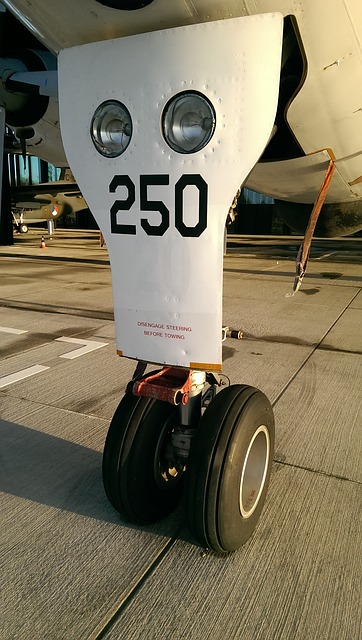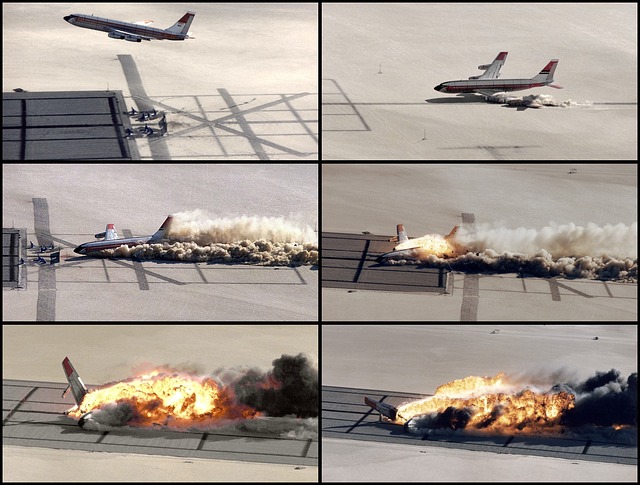It is absolutely imperative for an aircraft to be operational as a whole. The jet fuel, turbine engines, fuselage, electrical components, wings, and landing gear must all be functioning for a plane to receive a certified stamp verifying that it’s safe for flying. There’s no disputing this fact.
Very often many issues such as aircraft turbine failure can be avoided when using proper preventative inspections with tools like an aviation borescope. In this article, we’re going to take a closer look into landing gear and the importance of landing gear inspections.

WHY DO AIRCRAFT REQUIRE LANDING GEAR?
A commercial aircraft’s landing gear consists of large, main wheels situated at the middle of the plane near the wings. There is another set of wheels near the nose of the plane. This setup is known as the tricycle undercarriage, commonly seen on modern commercial jets. Each tire can only support a specific amount of weight. Meaning, the total number of wheels varies between three all the way to a whopping 32 wheels!
The larger and heavier aircraft typically have more wheels to help spread the weight of the plane more evenly over an entire surface area, resulting in less pressure on the pavement. For example, a Cessna 172 only has three wheels total because it weighs less. A Boeing 777 has 14 wheels total because it weighs significantly more.
As the aircraft takes on more weight, the specific amount of force that the touchdown creates increases. The surface of the runway can only take so much before it becomes damaged. Distributing the weight evenly over the tires reduces the force from the impact and the chances a tire will burst as it smacks the ground.


AIRCRAFT TAKEOFF & LANDING
Before the plane can even take off, it must be pushed back away from the gate. Many aircraft have the capability of moving backward by using reverse thrust but this may cause damage in the direct vicinity. It’s best for the plane to be pushed away and turned in the right direction.
As the aircraft slowly moves toward the runway, the passengers should already be buckled; seats in the upright position, and ready to go. After the pilot has been given the green light, the turbine engines power up and the plane picks up speed. In about 30 seconds, you’re flattened against your seat as the commercial jet obtains lift to get it into the air.
The landing gear (undercarriage) retracts into the plane as soon as the wheels are no longer touching the runway. There are several reasons for this. Firstly, it significantly reduces drag and improves the aerodynamics of the aircraft. However, it’s also for safety purposes. If an engine fails, they have a chance to restart the failed engine or make an emergency landing if necessary. The aircraft can speed up in an effort to restart the engine only if the gear has quickly been retracted.
During the landing, the thrust is reduced and the drag increased with the use of the flaps. The landing gear must also extend in order for the pilot to execute a normal landing. In the instance everything is fine, the main wheels touch the ground first, then the wheels at the nose of the plane touch down.
The pilot will use spoilers to drastically reduce the lift and force the weight of the plane to distribute to its wheels. Some use reverse thrust to aid in slowing down the plane after it touches the ground. If the landing gear works, as it should, the shock is absorbed and transferred to the rest of the landing gear for a safe landing.

A LOOK AT LANDING GEAR INSPECTIONS
When an aircraft is unable to land with its landing gear completely out then it stands the risk of several potentially dangerous outcomes. The aircraft could flip on landing, catch fire, and worse, many passengers and employees could lose their lives. Not to mention the associated costs with repairing the commercial aircraft due to missing the problem initially.
While environmental factors definitely play a part in the type of landing pilots must execute, these are often out of their control. Airline companies prepare for these situations by carefully examining the aircraft and its individual working parts. An aviation technician will want to use the top remote visual inspection (RVI) tools to help them see difficult-to-reach areas of the aircraft.
With all inspections, including the annual and 100-hr inspection, a visual inspection is conducted to find any noticeable damage to the landing gear. Tires must be inspected for bulges, erosion, embedded foreign objects, and other abnormalities. If there are any missing parts or tire problems, then the technician notifies the airline immediately to ensure the work stays on schedule.
Salt deposits, grease, oil, brake dust, and dirt cover the landing gear, making it incredibly dirty from frequent flights. The gear must be cleaned to remove the build-up. Only an approved cleaning method should be used and the parts must be inspected after cleaning.
The technician typically checks for corrosion, wear, alignment, and ensures the gear has not been bent. After the wheels are removed, the brakes are inspected for damage or wear. Since the type of brake assembly varies from plane to plane, the aviation technician should check the condition according to the manufacturer guidelines. Any sign of defects or improper functioning should be reported and replaced immediately.
Nondestructive testing with an aviation borescope can be used to check for cracks and leaks as well as other types of damage in areas that prove difficult to reach. Other areas of inspection include the retracting mechanism, such as the motors and wiring. Each valve, reservoir, and line must be free of leaks and securely attached. Warning systems should be clean and functioning.
To pass the inspection phase, each section must meet the guidelines set forth by the Federal Aviation Administration (FAA compliant). The shocks, tires, fixed/retractable gear, bolts, and wiring must be thoroughly examined on a regular basis by a qualified aviation mechanic.
SPI BORESCOPES OFFERS THE BEST AVIATION BORESCOPES
Landing gear inspections are a priority along with any other pertinent aircraft maintenance. SPI Borescopes offer the best in RVI aviation borescope technology. To guarantee the passengers’ safety, the commercial airline corporations must ensure their airplanes receive regular preventative inspections and maintenance on everything from the turbines to the landing gear.
Related Articles
Learn more about aviation borescopes and their real-world applications
Aviation Body & Engine
Aviation maintenance is a large and crucial part of the aviation industry as aircraft and engines are in constant need of inspection, preventative maintenance, and repair in order to keep these flying machines, running, effective and safe….
Most common aircraft turbine problems are avoidable with the use of an aviation borescopes to detect problems before they become disasters!
An aviation borescope is an invaluable piece of inspection equipment that any professional aircraft owner and mechanic need to have in their toolbox. Using one of these high-tech inspection tools can help….
How is An Aviation Borescope Used in a 100-Hr Inspection?
In the aviation industry, the use of borescopes is common as this is an invaluable inspection tool, and inspections are not only needed, they are required for most aircraft. Because of this, having a high-quality and reliable aviation borescope is a must for any professional ….
6 Warning Signs to Look for When Performing an Aviation Borescope Inspection on an Aircraft Engine
Aviation borescope inspection is an important practice on any aircraft. Inspection requirements vary by craft type, and usage. For example, commercial and military aircraft are required ….
3 Types of Rocket Engines Used for Space Travel that Undergo Aviation Borescope Inspections
Space travel almost seems like its routed in pure magic, but a ton of engineering and highly advanced parts go into to make this ‘magic’ actually possible. Whether it’s manned or unmanned space crafts ….
Why a Military Aircraft Needs More Aviation Borescope Inspections Than Commercial Aircrafts
In the United States Military, there are currently over 13,000 aircraft in service to help protect our country. These include everything from transport aircraft, fighter aircraft, trainer aircraft, and so much more….
3 Most Commonly Used Commercial Aircrafts that Utilize Aviation Borescopes
The inspection process of an aircraft is vital to maintaining the right performance and operation standards of any and all aircrafts. Without a proper inspection, an aircraft is likely to run with undiagnosed issues….
Commercial Airplane Wing Inspection
Airplanes involve many different parts working together to make certain it operates smoothly. Commercial airplane wings are particularly….


